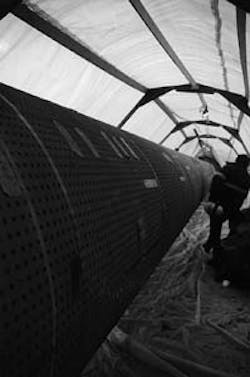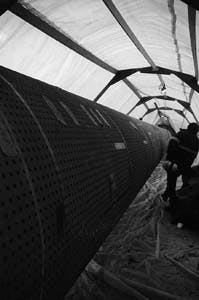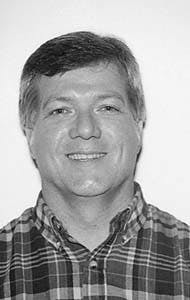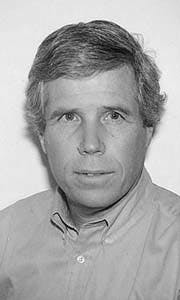Alyeska program allows pig performance comparison
Patrick H. ViethAlyeska Pipeline Service Co. in recent years has conducted numerous in-line inspections (ILIs) of its 800-mile system.
Kiefner & Associates Inc.Steven W. Rust
Battelle
Columbus, OhioElden R. Johnson, Michael L. Cox
Alyeska Pipeline Service Co.
Anchorage
Sites most affected by external corrosion have been identified, excavated, and evaluated based on subsequent field measurements of the corrosion.
The extensive database that resulted has proven invaluable for evaluating the performance of ILI surveys.
This database has provided information necessary for comparing the performance of different pigs. It has also been useful for applying knowledge obtained from past excavations to a decision-making process for identifying future excavation sites or candidate locations for alternative remediation such as cathodic protection upgrades.
The methods used in the Alyeska program, and presented here, permit one to optimize available data and compare them statistically with measurements of actual external corrosion. Results of the analyses can be used to quantify the performance of past and future inspections (detection, accuracy, etc.) and to quantify the added value of additional excavations and inspections.
The approach used to assess in-line inspection data as described here can be adapted by most pipeline operators to their particular situations.
Metal-loss locations
In-line inspection technologies provide pipeline operators with additional tools to ensure the structural integrity of their pipeline systems. These tools identify locations that have sustained corrosion-caused metal loss and locations that have been deformed from outside forces (third party, earth movement, etc.).
Recently developed tools have also shown promise for detecting crack-like defects in large-diameter pipelines. The analyses presented here consider only corrosion-caused metal loss indications.
ILI technologies for such metal loss have evolved significantly from first-generation tools. The analysis of the data produced by current high-resolution tools provides the length and depth dimensions of the corrosion anomalies.
The tendency to identify a single "worst-case" location, however, does not necessarily provide the best means for quantifying the impact of a high concentration of indications.
Methods discussed here provide means to decide whether it is better, for example, to investigate a location with 50 moderately severe anomalies or one with a single, slightly more severe, anomaly.
Alyeska uses ILI in its corrosion-control program and has conducted annual ILI surveys (more commonly referred to as "pig runs") since 1979. First-generation ILI tools were used before 1989 and were only capable of locating relatively severe corrosion (wall loss greater than 30-50%).
Second-generation ILI tools (both magnetic flux leakage and ultrasonic technologies) were used beginning in 1989 and have more realistically represented the status of corrosion on the pipeline.
Trans Alaska Pipeline System (TAPS), operated by Alyeska, is an 800-mile pipeline which transports crude oil from Prudhoe Bay to Valdez, Alas. (Fig. 1 [106495 bytes]). The pipeline consists of 48-in. OD pipe, 0.462 and 0.562-in. W.T., of API 5L X-60, X-65, and X-70 Grade.
The primary focus of Alyeska's ILI program is to monitor external corrosion on the 380 miles of buried line. No external corrosion problems have been identified to date on the 420 miles of aboveground pipe.
An extensive database of field measurements has been developed by Alyeska as a result of numerous pipe excavations conducted while responding to the annual pig runs. With the methods presented here, Alyeska has attempted to understand better the information provided from the pig runs and to apply the knowledge from past excavations when determining locations for future excavations or other alternative remediation.
Three goals have been achieved during the course of this Alyeska program:
- Development a database for evaluating in-line inspection results.
- Development of methods for quantifying the performance of an in-line inspection survey.
- Development of methods for incorporating knowledge obtained from past excavations and ILI surveys into a decision-making process.
An overview of the methods employed to accomplish the first two goals and the results of the analyses are presented here. Additional details of these analysis methods have been presented elsewhere.1 2
Presented here is an overview of the first two goals. An extended discussion of the third goal provides the rationale of how the results of employing this analysis can benefit development of a response plan.
Findings
The ILI surveys database has provided the information necessary to compare the performances of different pigs in the pipeline. It has also provided the means to apply knowledge obtained from past excavations into a decision-making process for identifying future excavation sites or candidate locations for alternative remediation measures such as cathodic protection system upgrades.
The database compiled by Alyeska includes detailed measurements of the actual corrosion identified from numerous excavations and the results of annual ILI surveys. The field measurements and ILI survey results are used to quantify the detection capabilities and depth measurement accuracy capabilities of the various tools used by Alyeska.
Results of the detection and depth-accuracy analyses are used to calculate the probability that, for a given pig-call depth, a 1.39 factor of safety is maintained between the predicted failure pressure and the maximum operating pressure (MOP).
These results, referred to as the "probability of exceedance," are used to quantify the likelihood that a critical depth of corrosion is exceeded based on the information provided by an ILI survey.
A standard method for determining a response plan to an ILI survey is to identify the most severe indications provided by the tool. These indications are generally determined by calculating the remaining strength of the pipe using the depth and length measurements provided by the tool.
When considering the uncertainty in the depth and length measurements provided by the tool, however, simply responding to the "worst case" indications may not always be the most appropriate response.
The "probability of exceedance" results produced by employing the analysis methods presented here provide a means to consider the effect of a high concentration of pig calls in a given location as opposed to simply assessing a single, isolated pig call.
For example, the results produced from these analyses may indicate that it is more appropriate to excavate a location containing six pig calls with a depth 150 mils as opposed to excavating a location containing a single pig call with a depth of 175 mils (1 mil = 0.001 in.).
Evaluating inspection results
The first step in this program was to develop a database that could be used to evaluate ILI results. This database consists primarily of in-line inspection results and field measurements. Additional data used in the analyses include pipe geometry, material grade, and hydraulic profile data.
The in-line inspection results are provided to Alyeska as pig-call data. These provide the axial location and axial extent of the corrosion, the circumferential location and width of the corrosion, and the minimum measured remaining wall thickness. The length and width dimensions are referred to as the "pig call box."
The number of pig calls provided from the ILI surveys has increased significantly in recent years. In 1991, there were 7,000 pig calls; in 1994, there were more than 67,000.
This increase results mostly from the tools' ability better to identify relatively shallow corrosion (<75 mils of wall loss). The number of pipe joints with pig calls less than 75 mils of wall loss increased from 935 joints in 1991 to nearly 10,000 joints in 1994.
(A "joint" is the length of pipe between girth welds. The pipe joints used in the construction of TAPS were typically 40 or 60 ft long. The 818-mile pipeline consists of 105,521 joints; 48,745 are buried.)
Table 1 [36228 bytes] presents the distribution of pig-call depths identified during the 1991-1994 surveys. This increase in the number of pig calls identifies the potential need for establishing alternative measures to evaluate the data.
After a section of pipe is excavated, field measurements of the external corrosion are obtained by developing a grid over an area of corrosion. This grid has a defined axial length and circumferential width.
The corrosion grid is further divided into 1-in. squares. For example, a corrosion grid 12 in. long and 12 in. wide would be divided into 144 1-in. squares. The minimum remaining wall thickness within each 1-in. square is then identified and recorded.
Fig. 2 (below) presents a typical excavation: the black dots are painted onto the pipe to define the 1-in. squares for acquiring the measurements.
Here is a typical excavation site along TAPS following an ILI survey (Fig. 2).
Alyeska used these corrosion grid data to assess the structural integrity of the corroded pipe. The recorded measurements within the corrosion grid are used to model the area of missing metal as a result of corrosion. RSTRENG3 4 is then used to calculate the remaining pressure-carrying capacity of the corroded pipe.
Of the 150 excavations completed since 1992, none of the areas of corrosion has been severe enough to affect the structural integrity of the pipeline. (That is, none required installation of a repair sleeve, a reduction in the maximum allowable operating pressure, or removal from service.)
The pipeline coating was replaced, however, and the cathodic-protection system upgraded within each excavation.
While the corrosion grids are appropriate for assessing the structural integrity of the pipeline, a modified presentation of these data was necessary to conduct a statistical comparison between the pig data and the actual field measurements.
A common unit of area, referred to as "segment," was used to divide pipe joints into smaller units and to represent the field measurement data obtained from each excavation. This presentation of the data was accomplished as follows:
- Each joint of pipe was divided into axial and circumferential segments (Fig. 3A [35124 bytes]). The length of the axial segment is calculated based on the total length of the joint and produced equi-length segments of approximately 4 ft for each joint of pipe. The actual length of the axial segment varied slightly between joints.
- The circumferential segment was fixed for each pipe joint. The three circumferential segments ranged 0-120°, 120-240°, and 240-360°. The width of each segment was 4.19 ft ([p ? 48 in.]/3). Therefore, a typical 40-ft joint of pipe would contain 30 segments (10 axial segments x 3 circumferential segments).
- Once the segments were established for each joint of pipe, the field measurements maintained in the corrosion grid data were used to identify the maximum depth of corrosion within each segment (Figs. 3b and 3c).
This process resulted in 2,246 segments being identified where at least 50 mils of wall loss was measured. These data are used to represent the field measurements for the detailed comparison. Table 2 [12130 bytes] presents the distribution of the depths of corrosion for the 2,246 segments.
Quantifying performance
Performance, as used here, describes the tool's ability to detect an area of corrosion and, once an area is detected, the tool's ability accurately to measure the corrosion.
The measurement capability of the tool includes its ability to measure the depth of corrosion and the axial and circumferential extent of the corrosion. Each performance measure, detection, and measurement accuracy is described.
There are several reasons for quantifying the performance of an ILI survey. First, the detection results identify whether the tool was capable of finding areas of corrosion.
Some tools, for example, may be better able to detect relatively severe corrosion, while others may be able to detect both relatively shallow and severe corrosion. The results of the detection analysis quantify the tool's ability to answer these types of questions.
Second, the measurement-accuracy results quantify the uncertainty surrounding the tool's ability accurately to measure the depth of corrosion. Results of quantifying the depth accuracy may provide insight into whether the depth of corrosion is generally under-stated (nonconservative) or over-stated by the tool.
Detection capabilities
The tool's ability to detect an area of corrosion is indicated by comparing the pig calls (Table 1) to the field measurements summarized by the 2,246 segments (Table 2).
A reasonable criterion for matching a corrosion pit to a pig call was established wherein the pig-call box was required to be within 12 in. of the corrosion pit within each segment. The 12-in. tolerance accounted for any inaccuracies in the location identified by the pig and any inaccuracies in recording the location of the actual field measurements.
Fig. 4 [35828 bytes] presents the detection results for one of the pig runs, Pig Run E. These results show that 68% (1,131 of 1,666) of the segments with pit depths between 50 and 100 mils were detected by the pig.
These results also show that the probability of detection increases with greater depths of corrosion. For example, 68 of the 70 segments with pit depths greater than 150 mils were detected by Pig E.
The results presented in Fig. 4 were analyzed statistically with probit analysis procedures to establish the curve presented through the data. The detection results for the other pig runs (A, B, C, and D) were analyzed in the same manner as Pig Run E. Fig. 5 [18918 bytes] presents the probit analysis results for all five pig runs.
These results show that it is possible to differentiate between detection capabilities of various in-line inspection tools. In fact, the results of these analyses agree with the intuitive belief of the performance of the various tools.
Measurement accuracy
Measurement accuracy can be described as the uncertainty or expected error associated with a pig measurement. Two aspects of measurement accuracy are considered within this analysis:
- Depth accuracy identifies the ability of the tool accurately to assess the actual depth of corrosion.
- Length accuracy identifies the ability of the tool accurately to assess the actual length of corrosion.
The tool's ability to measure the width of corrosion was not considered because it is not a variable in assessing the remaining strength of corroded pipe.
It was impossible to develop a relationship between pig call length and the actual length of corrosion within the efforts of this program. While the 1-in. spacing increment used for acquiring field measurement is adequate for its intended purpose of assessing the structural integrity of the pipe, it is inadequate for developing a relationship between pig-call length and the actual length of corrosion.
Additionally, more than 50% of all of the pig-call lengths are less than 2 in. long. This fact alone suggests that the 1-in. spacing increment is too large for developing a corrosion length relationship.
A relationship between pig-call depth and the actual depth of corrosion has been developed; Fig. 6 [19531 bytes] presents this relationship for Pig Run E.
These results show that there is a fair amount of scatter in pig-call depths for shallow pit depths. The results also show that there is not a significant amount of data for relatively deep pit depths.
Results for the relatively deep pits are often used when identifying the most critical areas of corrosion identified via ILI. This lack of data for deep-pit depths is considered in the methods presented here.
These data are analyzed with linear-regression techniques which assume a log-normal distribution of pig-call depths for a given pit depth. The lines presented through the data illustrate the results of the linear-regression analysis.
The solid line (1:1) is the line of perfect agreement between pig-call depth and pit depth. The upper and lower dashed lines represent the bounds within which 95% of the data lie (that is, the 2.5 and 97.5 percentiles). The center dashed line (AVG) presents the average predicted pig-call depth for a given pit depth.
A linear regression of the data was conducted for each of the five pig runs (A, B, C, D, and E), the results of which are presented in Fig. 7 [17600 bytes] in which the average predicted pig-call depth has been calculated for a given pit depth based on the linear-regression results.
The slope for each line in Fig. 7 indicates the strength of the relationship between the information that the tool provides in regard to the actual depth of corrosion.
For example, the slope of the line for Pig Run E is the closest to 1.00 and suggests the strongest relationship between pig calls and the actual depth of corrosion. The slope of the line for Pig Run D suggests that it provides the least amount of information regarding the actual depth of corrosion.
(Some problems encountered in Pig Run D may have affected the results.)
In summary, the detection capabilities and depth-measurement accuracy capabilities of Pig Run E appear to be superior to other pig runs. Therefore, only Pig Run E will be used for incorporating the results of the previous analyses into a decision-making process.
Incorporating results
If the results of the detection and the depth-measurement accuracy analyses are to be incorporated into a decision-making process, the first problem that needs to be addressed is how to handle the results presented in Fig. 6.
These results provide an expected range of pig-call depths for a given pit depth. The question that most needs to be answered, however, is the expected range of pit depths given a pig call.
This problem is resolved by employing a statistical technique (Bayes theorem) to determine the expected range of pit depths given a pig call. This is accomplished by incorporating an expected distribution of pit depths.
This distribution accounts for the fact that relatively shallow corrosion has been identified in previous excavations and that the likelihood of finding deep corrosion in future excavations is less than finding shallow corrosion. Fig. 8 [46788 bytes] presents an overview of this approach.
Fig. 9 [18376 bytes] presents the results of applying the Bayesian statistical techniques to Pig Run E. The dashed lines in this figure represent measurement uncertainty or the expected range of pit depths given a pig-call depth. The upper and lower dashed lines are the bounds within which 95% of the pit depths are expected to lie (that is, the 2.5 and 97.5 percentiles).
Fig. 9 also presents the distribution of pit depths for a pig-call depth of 150 mils. For a 150-mil pig call, the expected value of the actual pit depth is about 120 mils.
Additionally, it is fairly certain that the actual pit depth is less than 190 mils, 97.5% of the time. This type of distribution is ultimately used to evaluate the likelihood that a 150-mil pig call is 50 mils, 130 mils, or 180 mils of actual corrosion, for example.
For each joint of pipe, a critical depth (CD) of corrosion is calculated based on pipe geometry, grade of material, maximum operating pressure (MOP), and a defined length of corrosion. This CD corresponds to the maximum depth of corrosion that can be tolerated and still maintain a 1.39 factor of safety between the MOP and the predicted failure pressure.
CD is calculated via a transformation of the modified B31G equation (also referred to as the RSTRENG 0.85 area method).3 (Calculating CD uses the equations in the accompanying box.)
As long as the depth of corrosion is less than CD, a 1.39 factor of safety is maintained between the MOP and the predicted failure pressure.
Once CD has been established, it is possible to evaluate the likelihood that the actual depth of corrosion may exceed CD for a given pig call. For example, Fig. 9 presents the distribution of pit depths for a 150-mil pig call.
If CD is calculated to be 250 mils, it is unlikely that the actual depth of corrosion exceeds CD for the 150-mil pig call. If CD is calculated to be 200 mils, however, it is more likely that the actual depth of corrosion exceeds CD for the 150-mil pig call.
Fig. 10 [22185 bytes] better summarizes the predicted pit-depth results. The estimated probability that the actual corrosion exceeds a specified depth (CD) is presented for an array of pig-call depths as shown by the dashed lines (75, 150, and 225 mils; one can readily establish similar curves for any pig-call depth; only three curves are presented here to show the expected range of results.).
These curves are generated based on the depth-accuracy results presented in Fig. 9.
The bottom dashed line in Fig. 10 ("No pig call") represents the probability of exceedance when there is no pig call. This curve is generated based on the probability of detection curve presented in Fig. 4 [35828 bytes]. It represents the confidence that no corrosion exists in segments where there is not a pig call.
The solid curve presented in Fig. 10 ("Expected Distribution of Pits") represents the overall probability for a given depth of corrosion based on the assumed distribution of pits.
This is the assumed distribution of pits used in the Bayesian statistical techniques employed in these analyses. The results presented in Fig. 10 can be used to calculate the probability of exceedance for any combination of CD and pig call depth.
Application of results
There are several advantages to producing results in terms of the probability of exceedance.
First, these results embody all the variables encountered in assessing the severity of corrosion based on a pig call: pipe geometry, grade of material, hydraulic profile, tolerable depth of corrosion to maintain a 1.39 factor of safety, and depth of corrosion provided by the pig.
Second, the probability of exceedance results can be used to evaluate the combined effect of multiple pig calls located nearby and thus provide a means to incorporate the density of pig calls into the results.
Here is an example of how this works:
First, the critical depth (CD) of corrosion for the location of interest is calculated using the first equation in the accompanying box. If the location consists of 48-in. OD, 0.462-in. W.T., API 5L X-60 material and the MOP is 825 psig (71% specified minimum yield strength, SMYS), CD is calculated to be 200 mils. This calculation assumes a length of 6 in.
Assume that the location of interest contains a pig call in six adjacent segments (Fig. 11 [45521 bytes]) and extends axially 16 ft. Each square in Fig. 11 represents a segment as previously defined and covers an area of approximately 16 sq ft. The pig-call depths are presented next to the "circle" representing each pig call.
For each pig-call depth, the probability of exceeding the critical depth of corrosion (200 mils) is determined from Fig. 10 for each of the 12 segments presented in Fig. 11. The results are presented in Fig. 12 (graphic not available) where the pig-call depth is presented in bold and the probability of exceedance is presented in the parenthesis.
The overall probability of exceedance (PTOTAL) for the 12 segments is calculated as follows:
PTOTAL = 1 - [(1 - P1)(1 - P2)...(1 - P12)] = 6.1 X 10-2
where:
P1 - P12 = Probabilities of exceedance for each of the 12 segments.
The probability of exceedance for the maximum depth of corrosion (175 mils) was 2.0 x 10-2. By considering that there were other relatively severe pig-call depths nearby, however, the probability of exceedance increased by a factor of 3 (200%) to 6.1 x 10-2.
A majority of ILI response plans focus primarily on the "worst case" pig call. These response plans would generally not consider other relatively severe pig-call depths nearby. As mentioned earlier in the discussion of measurement accuracy, there is reasonable uncertainty in the depths of corrosion identified via ILI. This conclusion suggests that it may be more appropriate to consider the effects of a concentration of pig calls rather than solely responding to a "worst-case" pig call.
A few interesting concepts result from applying the approach described:
- The total probability of exceedance (PTOTAL) will never be less than the maximum probability for any of the individual pig calls being evaluated. Therefore, PTOTAL can only increase from the maximum probability, depending on the contribution of pig calls close by.
- PTOTAL can be calculated for any number of pig calls identified for any location. For example, it is possible to calculate PTOTAL for every joint of pipe covering the 380-miles of buried pipe. These results can be used to identify the joint of pipe that has the greatest probability of exceedance.
It is also possible to conduct a "sliding" calculation along the pipeline to determine the maximum PTOTAL for various locations.
For example, because a typical excavation extends 60 ft axially, it is possible to identify the greatest probability of exceedance (PTOTAL) that lies within an 60 ft section. This is accomplished by "sliding" down the pipeline and calculating PTOTAL for every 60-ft length.
These results can be used to identify locations that can be considered for possible excavation.
It is also possible to use these results for identifying larger areas (for example, 1-mile segments) that are possible candidates for alternative remediation measures. The 1-mile sections that have the largest PTOTAL could be potential candidates for cathodic-protection upgrades or other alternative remediation, as opposed to solely using the results for defining excavation sites.
A method to quantify the added value of excavations has also been established. The total probability of exceedance can be summed for the entire 380 miles of below ground pipe (PLine Total). The added value of excavations can be quantified by comparing the reduction in the total probability to PLine Total.
This type of comparison may show, for example, that the total probability of exceedance may be reduced by 50% by conducting ten excavations.
These methods for evaluating ILI surveys are developmental in nature and continue to be refined. The methods and results presented here are being considered by Alyeska as an additional or alternative method for evaluating response plans to ILI surveys. Ultimately, these methods may be incorporated into a risk management decision-making process.
Acknowledgment
The authors wish to acknowledge John Kiefner, Kiefner & Associates Inc., for his technical input throughout this project and Fred Todt, Battelle, for the data management and statistical analysis support.
References
1. Vieth, P.H., Rust, S.W., Johnson, E.R., and Cox, M.L., "Corrosion Pig Performance Evaluation," National Association of Corrosion Engineers (NACE), NACE/96, Denver, March 1996.
2. Rust, S.W., Vieth, P.H., Johnson, E.R., and Cox, M.L., "Quantitative Corrosion Risk Assessment Based on Pig Data," National Association of Corrosion Engineers (NACE), NACE/96, Denver, March 1996
3. Kiefner, J.F., and Vieth, P.H., "A Modified Criterion for Evaluating the Remaining Strength of Corroded Pipe," American Gas Association, Pipeline Research Committee, Catalog No. L51609, 1989.
4. Vieth, P.H., and Kiefner, J.F., "RSTRENG User's Manual," American Gas Association, Pipeline Research Committee, Catalog No. L51688, Mar. 31, 1993.
The Authors
Patrick H. Vieth joined Kiefner & Associates Inc. in 1991 after 5 years at Battelle. He received a BS in mechanical engineering from Ohio State University, Columbus.
Steven W. Rust is a senior statistician in the statistics and data analysis systems group at Battelle. For the past 5 years, he has served as lead statistician for the Gas Research Institute's pipeline simulation facility. Rust earned MS and PhD degrees in mathematical statistics from Ohio State University.
Elden R. Johnson has been involved with Alyeska for nearly 23 years. He has been in various engineering and management positions during design, construction, and operation of TAPS. In the past 6 years, he has been a corrosion engineer. Johnson holds a BS in civil engineering from Michigan State University, an MS in civil/geotechnical engineering from the University of Illinois, and an MS in engineering management form the University of Alaska, Anchorage.
Michael L. Cox has been a corrosion engineer in Alyeska's system integrity department for the past 6 years. Cox joined Alyeska in 1990 after an engineering position at Schlumberger in the wireline and well services division. He received his BS in engineering geology from the University of Mississippi, Oxford.
Copyright 1997 Oil & Gas Journal. All Rights Reserved.





